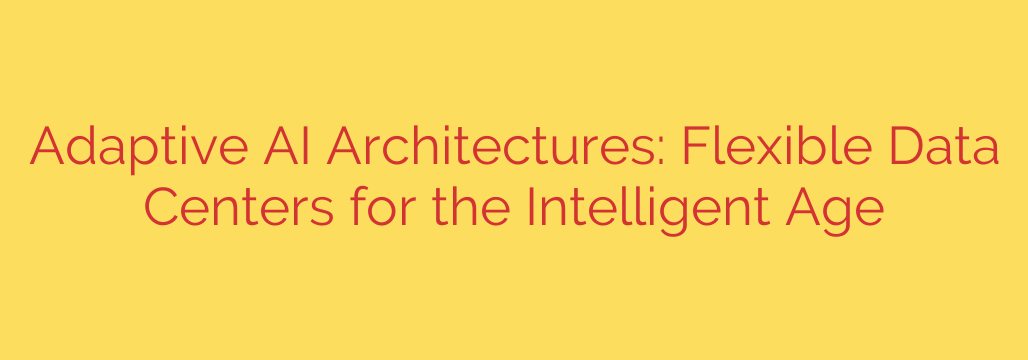
Powering the Future: Why Adaptive AI Architectures Are Essential for Modern Data Centers
The era of artificial intelligence is here, driven by resource-intensive applications like generative AI and large language models (LLMs). These groundbreaking technologies are not just changing our world; they are fundamentally breaking the traditional data center models we’ve relied on for decades. The static, rigid infrastructure of the past simply cannot handle the sheer scale, density, and dynamic nature of modern AI workloads.
To unlock the full potential of AI, a new approach is required—one built on flexibility and intelligence. This is the role of adaptive AI architectures, a design philosophy poised to become the new standard for high-performance computing.
The Breaking Point: Why Traditional Data Centers Falter with AI
For years, data centers were built around predictability. But AI workloads are anything but predictable. They create a perfect storm of challenges that legacy systems are ill-equipped to handle:
- Extreme Power Consumption and Heat: Training a single large AI model can consume megawatts of power. The resulting heat generated by densely packed GPUs far exceeds the cooling capacity of traditional air-based systems, leading to performance throttling and hardware failure.
- Fixed Hardware Ratios: Classic server design locks CPUs, memory, and accelerators (like GPUs) into a fixed box. If an AI task needs more GPU power but not more CPU, entire servers sit underutilized, wasting both capital and energy.
- Inflexible Scalability: Scaling a traditional data center is a slow, manual, and expensive process. It can’t dynamically reallocate resources to meet the fluctuating demands of different AI tasks, such as the shift from high-intensity training to low-intensity inference.
These limitations create bottlenecks that stifle innovation, drive up operational costs, and prevent organizations from keeping pace with the rapid evolution of AI.
Defining the Solution: What Is an Adaptive AI Architecture?
An adaptive AI architecture is not a single product, but a strategic approach to designing data centers for agility and efficiency. The core principle is to move away from rigid, monolithic servers toward a more fluid and modular environment.
Think of it as shifting from a pre-fabricated building to a system of high-tech LEGO bricks. Instead of being locked into a fixed configuration, an adaptive architecture allows you to compose and recompose resources on the fly to perfectly match the specific needs of any given workload.
The goal is to create an infrastructure that can dynamically allocate the right resources, in the right amount, at precisely the right time.
The Core Pillars of a Flexible AI Data Center
Building a truly adaptive AI infrastructure rests on several key technological pillars working in harmony.
- Resource Disaggregation: This is the foundational concept. It involves physically separating core components—compute (CPUs, GPUs), memory, and storage—into independent, shareable pools. These resources are then connected by a high-speed, low-latency fabric. This allows an application to pull exactly the resources it needs (e.g., 2 CPUs, 8 GPUs, and 1TB of memory) without being constrained by the physical limits of a single server box.
- Advanced Liquid Cooling: As GPU racks become denser and more powerful, air cooling is no longer a viable option. Direct-to-chip liquid cooling is becoming essential. By circulating fluid directly over hot components, it removes heat far more efficiently than air, allowing processors to run at peak performance without throttling and enabling much denser hardware configurations.
- Software-Defined Infrastructure (SDI): This is the intelligence layer that manages the disaggregated hardware. Through sophisticated software, administrators can programmatically provision and automate the allocation of resources. SDI makes the fluid, on-demand nature of the adaptive architecture possible, transforming a complex collection of hardware into a single, cohesive, and agile system.
- High-Speed Interconnects: For disaggregated resources to function as a unified whole, the communication between them must be lightning-fast. Technologies like NVLink, InfiniBand, and specialized high-speed Ethernet fabrics are critical for eliminating data transfer bottlenecks between processors and memory pools.
The Tangible Benefits of an Adaptive Approach
Adopting this modern architecture delivers clear and compelling advantages that directly impact both performance and the bottom line.
- Future-Proofing Your Investment: The modular, disaggregated design allows you to upgrade individual components (like GPUs) as new technology emerges, without needing to replace entire server fleets. This extends the life of your infrastructure and protects your investment.
- Maximized Performance and Utilization: By precisely matching resources to workloads, you eliminate underutilization. Every processor, every gigabyte of memory is put to productive use, ensuring you get the most out of your hardware.
- Enhanced Efficiency and Cost Savings: Better utilization and advanced liquid cooling lead to significant reductions in power consumption and a lower Power Usage Effectiveness (PUE) ratio. This translates directly into lower operational costs and a smaller carbon footprint.
- Unprecedented Agility: An adaptive architecture allows you to spin up complex, custom-configured environments for new AI projects in minutes, not weeks. This agility is a powerful competitive advantage, accelerating the entire cycle of research, development, and deployment.
Actionable Security Tips for Your AI Infrastructure
A dynamic, software-defined environment requires an equally dynamic security posture. As you plan your adaptive architecture, prioritize these security measures:
- Implement a Zero-Trust Model: In a disaggregated system where workloads and data are constantly moving, you cannot rely on a traditional network perimeter. Treat every request as a potential threat, verifying identity and permissions rigorously, regardless of where the request originates.
- Secure Data at Every Stage: Protect your sensitive training data and proprietary AI models with robust encryption, both at rest on storage systems and in transit across the high-speed fabric.
- Automate Security Monitoring: Use AI-powered security tools to continuously monitor the complex, distributed environment for anomalies and potential threats. Manual oversight is simply not scalable enough for this new paradigm.
The future of computing is intelligent, and it demands an infrastructure that can keep up. Adaptive AI architectures are no longer a futuristic concept but a present-day necessity for any organization serious about leading the next wave of technological innovation. By embracing flexibility, modularity, and intelligence in the data center, you can build a foundation that is ready for the challenges of today and the opportunities of tomorrow.
Source: https://cloud.google.com/blog/topics/systems/agile-data-centers-and-systems-to-enable-ai-innovations/








